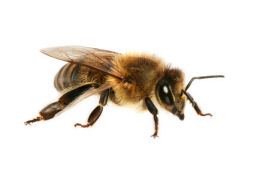Bumble and Honey Bee Stings
Visit this
PICTURES OF RASHES PAGE
Before discussing bee stings, their skin symptoms and their treatments, it is useful to look at some general information about bees.
General Information About Bees and Bee Stings
Despite the fear that many people have of bees and stings, they do play a useful role in our world. Bees are important pollinators. They pollinate our food crops and plants and provide us with honey.
Bees generally mind their own business and do not bother humans. Therefore, a bee sting treatment is not usually something that is considered important. However, in certain situations bees will sting. For example, bees will sting to defend their nest or to defend themselves when provoked or trapped. Under these circumstances, knowledge about sting treatment procedures is very useful.

A sting is more likely to occur in the spring and summer and on bright sunny days. Under these conditions, bees are much more active.
Compared to wasps, bees are bigger bodied and hairy. They have flattened hind legs that they use to collect and transport pollen.
There are many different species of bees. The two most common are bumblebees and honeybees.
Bumblebees
Bumblebees are on average 10 mm to 20 mm long (sometimes up to 35 mm) and are found throughout North America in woods or open fields. There are many types of bumblebees in the world. About 200 different species have been identified. Nests can be found in areas such as compost piles, woodpiles, old rodent burrows, wall cavities, etc., and may contain from 50 to 500 bees. Bumblebees are large and robust, hairy or fuzzy, and black and yellow in color. Often these bees have white or orange or even red bands. They do not eat insects, but rather prefer nectar and pollen from flowers.
These bees have a smooth stinger and therefore, normally do not leave their stinger behind in a person’s skin when stinging. The smooth stinger also means that they can sting repeatedly. Therefore, the sting treatment required for bumblebees is a little different than for a honeybee.
Honeybees
Honeybees range in size from 10 mm to 20 mm. The bees in this family type are hairy and yellow to black in color. The colors are either solid or striped. They are often seen carrying pollen on their hind legs.
Honeybees are found worldwide in temperate, subtropical, and tropical areas. They are responsible for more than 80% of the pollination required by most fruits, legumes, and vegetable seed plants.
Honeybee nests are usually found in hollow trees or manmade structures such as in voids in building walls or other similar protected areas. Their nests consist of a series of vertical honeycombs made of wax. Of course, these bees may also be in colonies managed by beekeepers. These colonies are kept in wooden hives. Colonies can consist of several thousand bees.
In addition to honey, honeybees provide other products such as beeswax.
Honeybees have a barbed stinger that remains in the victim after the sting occurs. The stinger contains a sac with contains venom and it continues to pump venom into the skin after the sting has occurred and the bee is gone. As will be discussed later, a key bee sting treatment is the removal of this stinger. Once this type of bee stings, it will die shortly afterwards.
Like most other bees, the honeybee is passive and will only sting when provoked or forced to defend the hive. However, the Africanized honeybee or killer bee is much more aggressive. A bee bite treatment is likely necessary when these bees are around because they attack their victims in swarms and the stings are more venomous that for other bees.
Related information on bees and stings:
bee stings | symptoms | treatments
